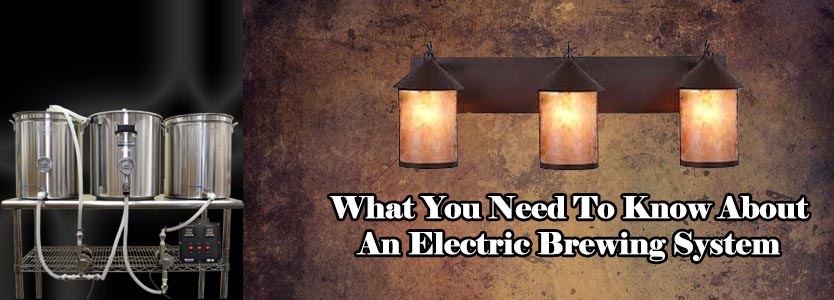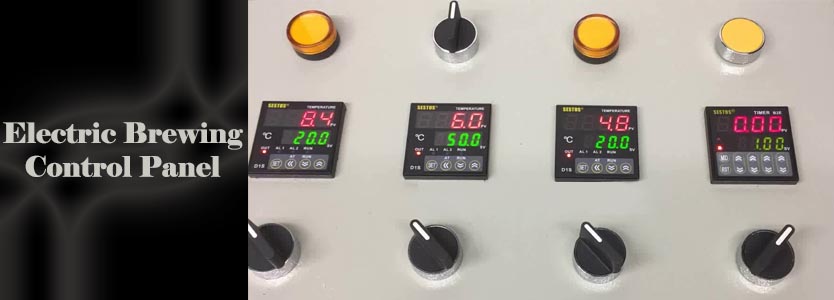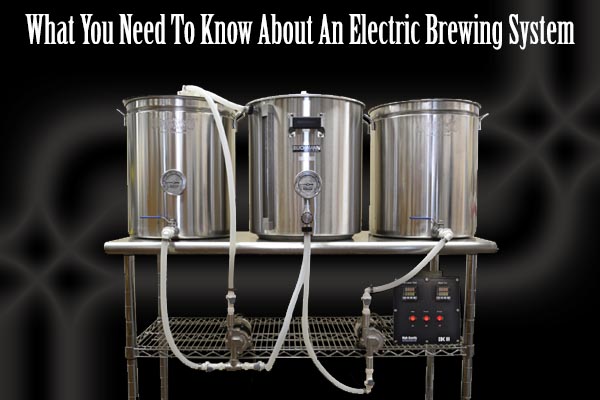If you’re looking to step up your game with all grain home brewing than you need to look no further than moving towards an electric brewing system. These systems have a tremendous amount of benefits to the messy stove top brewing you might be used to. The process is easier and the mess is less. Lastly, once the initial installation is complete the brewing process is safer than the flammable gases and carbon monoxide you could possibly be exposed to.
It’s worth noting that these systems require welding and electrical skills to properly set the systems up. If you don’t have those skills, or aren’t willing to hire someone with those skills, than installing an electrical brewing system may not be right for you. In fact, most homebrewers won’t ever use a RIMS or HERMS brewing system for their home because they’re more complex and require more maintenance.
Luckily, there is another alternative if you don’t have the skill and don’t want to hire someone with the skill. If you have some money to spend you can purchase a turnkey brewing system. We’ll discuss the turnkey brewing systems more later on.
What Is An Electrical Brewing System
An electric brewing system runs on electricity. Well, you probably already figured that one out. An electrical brewing system is a a little different than what you probably used when you started homebrewing. You probably started brewing on your gas stove top or with a propane burner. Where that liquid was having heat forced on the outside an electric brewing system is heated directly from the inside. We’ll get into the two systems in a bit, but this brewing method allows for a lot of benefits to the brewer which we’ll also discuss.
Because the system is electric you can brew inside or wherever there is a plug. You’ll want to look into each system before moving forward because you might need more than one circuit. But you can brew anywhere, and you won’t have any buildup of flammable gases or carbon monoxide. This might really help those of you in the north to brew all year round in more comfort. Overall, this system makes brewing a lot easier. There’s less mess and no heavy lifting.

Whats The Difference Between A RIMS Brewing System And A HERMS Brewing System
There are two advanced electric brewing systems for you to consider. These systems will help with maintaining mash temperature, automating the brewing process, and improving consistency from one batch to another in all grain home brewing. These two systems are the RIMS brewing system and the HERMS brewing system.
Each uses a pump and heating element in order to maintain that stable mash temperature during brewing. There is a misconception about the heating element. Some think that the heating element in an electric brewing system is in direct contact with the wort. This isn’t the case. The heating element is surrounded by a cloud of vaporized water, and as long as it is fully immersed the temperature will not rise above a certain point.
Now let’s bullet point the benefits of moving to an electric system.
Benefits Of The RIMS And HERMS Electric Brewing System
- These brewing systems work well as you start brewing larger batches of beer because you’ll have better heat consistency. The larger volume is more likely to develop hot and cool spots in the mash tun over time. Also, most stainless vessels are not insulated and conduct heat relatively well which makes it hard to maintain a consistent temperature. A temperature drift can make it difficult to control which enzymes are working on your beer.
- With the wort being continuously recirculated you’ll have a much clearer wort.
- You may like a recipe and want to brew it again. Whether it’s an existing recipe or your own recipe you’ll find it easier to replicate. You’ll see consistency in the brew results, and you’ll also find tweaks to the recipe are easier to make. You can experiment without worry!
- Another benefit to an electric brewing system is that you can perform complex mash schedules. These systems allow you to easily step through your temperature stops without much effort. You can now go without boiling water infusions or decoction mash additions to raise the mash temperature to the next stop.
- Much less energy is wasted with this system. At 10 cents per Kilowatt-hour it costs about 25 to 50 cents per hour to run an electrical brewing system. The performance can also be superior to gas. Starting at 55 deg F, you can raise the temperature of 15 gallons to 170 in 35 minutes. This is also typical of 30 gallons with two heating elements.
Both systems offer similar performance for the brewer. Often, a RIMS system is easier to construct. The HERMS brewing system doesn’t use as many parts as the RIMS system. It also uses less energy. But it is more difficult to set up than the RIMS brewing system.
Rims Brewing System
The RIMS Brewing system, short for Recirculating Infusion Mash System, is a system that recirculates the mash. Rather than infusing hot water and letting the mash tun slowly cool a RIMS system uses a pump to cool the mash. The pump constantly recirculates and heats the water to maintain temperature which will also avoid hot spots. The system uses direct heat on the tube to heat the wort as it’s recirculated. Typically, an electric brewing controller is used to turn the heat source on and off in the pump line to maintain a constant mash temperature. It also provides the variable heat source that’s required. Now let’s talk about how a RIMS brewing system actually works.
The system works by first pumping the wort from the base of the Mash Lauter Tun (MLT) and through a heater. The pump keeps the wort moving through the tube at a steady rate to avoid scorching it. The pump must run continuously during the mash when heating, though the heater itself is often cycled on and off to control temperature. Because the wort is being recirculated, clarity is promoted because the wort is being filtered through the grain bed during the mash. An even temperature is also maintained throughout the mash which permits brewers to raise the mash temperature easily.
Herms Brewing System
The HERMS Brewing System, short for Heat Exchange Recirculating Mash System, is similar to the RIMS system. But the HERMS system takes advantage of the hot water contained within the Hot Liquor Tank (HLT) that will eventually be used for sparging. In the most common setup wort is passed through a heat exchanger. This is much like an immersion chiller because it’s a coil of metal tubing which is usually made of copper within the hot liquor tank. As wort flows through the coil, heat is transferred from the hot water, through the metal tubing, and into the wort. In all other aspects, the HERMS system is the same as RIMS system and achieves the same goals.
The water in the HLT is usually kept a few degrees above the set temperature of your mash to minimize the time it takes to heat the wort. A temperature sensor is usually placed in the flowline of the wort just past the heat exchanger in this case.
The Electric Brewing Control Panel

An electric brewing control panel is a critical part of the electric brewing system. But we need to first talk about some safety. The control panel is a high current and high voltage brewing system. So you want to make sure you understand how everything works, especially, if you’re working on it yourself. A GFCI protected source is absolutely mandatory if you like living your life.
In fact, I’m going to defer the explanation and setup of the brewing control panel to skrilnetz.net. They have more experience with it than I have, and I definitely don’t want to guide anyone in the wrong direction.
Brewing Sculptures
An electric brewing system could take up quite a bit of space. So it’s important to have a brewing sculpture. A brewing sculpture will hold all of your vessels plus all of the accessories that you’ll need for the brewing system. This would include parts like your pumps, burners, chillers, and plumbing. A brewing sculpture will make your brew day much easier to manage all of the processes and help you stay more organized.
There are three popular designs for brewing sculptures:
- Single tier – usually designed to be low so the brewer can monitor the vessels without a ladder. It’s safer since no vessels are above the brewers head.
- Two tier – two vessels at the same height and one below or above. In this system, one of the transfers can be done by gravity, but the other will need a pump or some manual means of transfer.
- Three tier – uses gravity to move the fluids from one vessel to another and eliminates the need for pumps.
Most brewing sculptures are made of steel and are either welded or bolted together. If you are a DYI’er you could construct your own brewing sculpture out of wood or other sturdy material. But the design you choose is personal preference based on how you want to brew. All three designs share some common traits. Burners are usually mounted to the frame with wind guards. The fuel (propane or natural gas) is usually fed from a manifold to control valves for each burner.
You can hard-plumb valves for the wort and water. This will help control the flow to the various vessels. If you don’t want to hard-plumb you can use a “quick disconnect” system. This can save you a lot of money over the more complex piping and valves in a hard-plumbed system.
A Turnkey Brewing System
For those of you that may not want to dive into electrical and plumbing you can consider a turnkey brewing system. These turnkey systems will require minimal assembly and would include everything you need. Depending on how many vessels your setup will include you can spend as little as around $900.00. The concept is the same as the RIMS-HERMS system, but these are all ready to go for you.
High Gravity has some really good turnkey brew systems for you to choose from. So if you want to go electric with the least amount of fuss this could be the way to go.
Final Thoughts On An Electric Brewing System
All grain home brewing could be a challenge for any home brewer. That’s why many brewers use malt. Going electric makes all grain brewing easier because of the temperature control. If you have the money to spend an electric brewing system would be an absolute win for any homebrewer. You’ll have consistent and better tasting brews. And outside of the initial setup going electric would just be safer. You’ll also save some energy costs. For those of you living up north or somewhere that would prevent you from brewing all-year round the electric brewing system is your answer.

